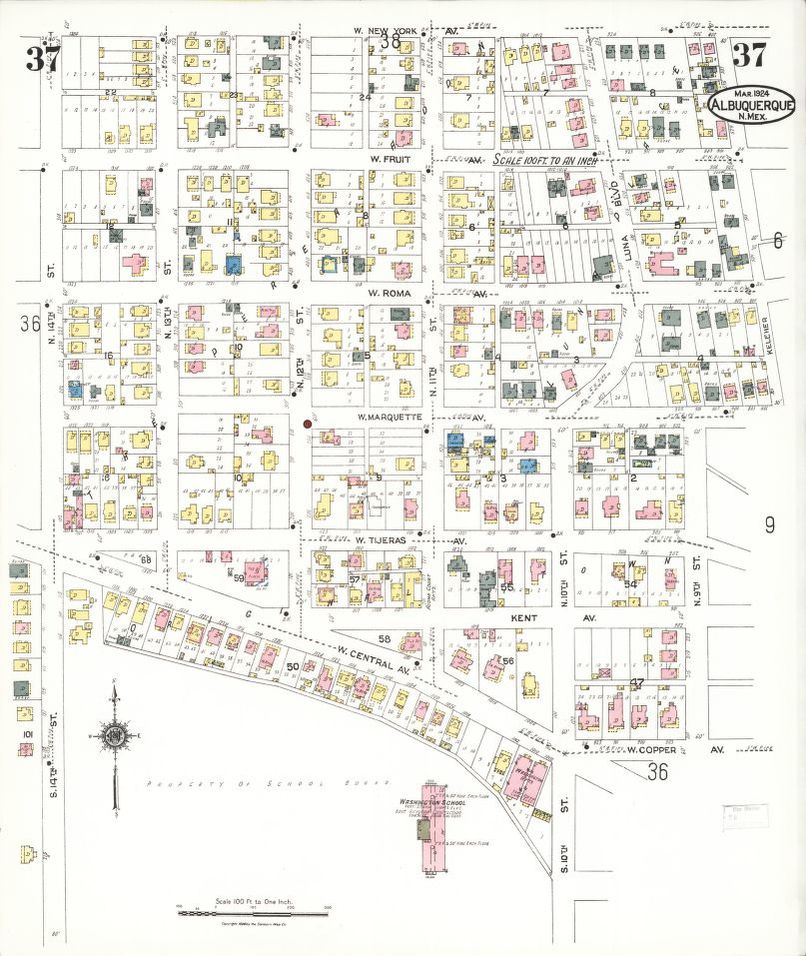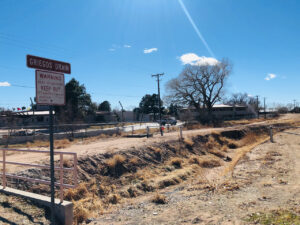
Aldo Leopold lived here, at the end of “New Albuquerque”, in the early 20th century
In the early 20th century, before Aldo Leopold became Aldo Leopold, the young forester lived on what was then the edge of Albuquerque’s expanding urban fringe.
135 14th St. SW SE sits today as a fine example of early 20th century “bungalows” that you might find in many western American cities. But when Leopold lived there when the house was built in the teens, 14th street was the edge of a city striving to modernity – growing city to the east, Rio Grande swampland to the west. A 1918 map I’ve got (not gonna post it, it’s super pixelated and poor resolution when you zoom in to Aldo’s house) shows 135 14th SW SE as literally the last house at the edge of the swamp.
The draining of that swampland, and much like it up and down what we in New Mexico call “the middle Rio Grande Valley”, is a central piece my friend and colleague Bob Berrens and I are zeroing in on as we begin dimly seeing the outlines of “our new book” emerge from our pandemic discussions.
The question we’re wrestling with involves the feedback between the evolution of Albuquerque as a city and the water management institutions the community created – community shapes institutions, which then shape community. Central to the story is a water management widget called the Middle Rio Grande Conservancy District, created in the 1920s to provide flood control, drainage, and irrigation.
Central to the Conservancy District story is Leopold, who spent two years (1918-19) running the Albuquerque Chamber of Commerce. Historian Denise Holladay Damico has written about Leopold in those years:
Leopold advocated passionately for the need for a centralized water conservation district, and the establishment of a civic center and civic identity, and city parks bordering the Rio Grande (which runs through the middle of the city). These same issues continue to swirl in public discourse today. At the heart of these debates are tensions between the individual accrual of private property and various notions of the public good. In his capacity as Chamber of Commerce Secretary, Leopold asserted that (what he called) “public spiritedness” was the way to resolve these tensions; however, just a few years later he publicly excoriated Albuquerque’s boosters for being short-sightedly profit-driven, suggesting some of the difficulties involved in balancing private rights with the public good. Can a “land ethic” be applied to American cities?
At the time, aggradation of the Rio Grande from the buildup of silt was a huge problem. The common explanation, which Bob and I will need to test, is that massive sheep overgrazing was contributing to erosion in upstream watersheds, which was raising the riverbed and therefore the water table through Albuquerque. Farmland was no longer farmable, flooding was increasingly common.
The young Leopold’s home was on the edge of one such swamp, so he had a very visceral understanding of the argument in favor of drainage. (Leopold had married into the Lunas, one of New Mexico’s wealthy ricos – the sheep families – see Wallace 2014 and the delightful Gulliford 2017 – it’s a complicated tale.)

Drains like these, built to lower the water table, serve as back alleys to New Mexico’s Middle Rio Grande Valley
The layers of colonization – Spanish immigrants from the south pushing aside native Pueblo communities, Pueblos pushing back, then Anglos from the east pushing aside both – play out in the formation of the Conservancy District, as the most recent layer of “modernization” was locked down across the Rio Grande valley floor.
The drains were built, one just a half mile southwest of the old Leopold home. The land between Leopold’s house and the river, once swamp, is now one of Albuquerque’s leafiest neighborhoods, including our Country Club. And the community was changed in complicated ways that Bob and I need to spend time disentangling.
Out riding Saturday, on a whim I diverted from the paved Rio Grande Boulevard onto the Griegos Drain ditchbank. Most of these valley ditchbanks are rideable – some little more than footpaths, others, like the Griegos, full-fledged dirt roads. Here, we think the drain’s construction in the 1930s wiped out the upper reaches of the old Barelas Ditch, which seems to have watered farms tended by our old friend Max Gutierrez and his many siblings.
What did they grow? Why did they stop? The clash between modernism’s drains and the old acequias is a central piece of the story.
I followed as best I could the path the Barelas Ditch had followed – past what we think was Max’s house (still there), down one of the crazy angled valley roads that you often find plopped down atop the old acequia routes. Past the freeway gas station on Second Street, beneath a place that rents cherry pickers, under the freeway and across the railroad tracks. The old Martineztown neighborhood, once built around the Barelas, is still there, and if you follow the ditch path far enough south you’ll find a little urban park commemorating the “Acequia Madre” that once flowed south here. At its east end the park opens onto Manuel’s, the last of the little neighborhood markets, which in pre-pandemic days smelled of the tamales the owner kept hot in a steamer – great bike ride snacks.
Here, the path of the Acequia Madre itself, now an alley, is fenced off.
The owner of Manuel’s, a woman New Mexicans would describe respectfully as an abuelita, buys the tamales in bulk from Costco.
Modernism is complicated.
Max will be in our story for sure. He’s an amazing character – bridging cultures, bridging past and future. One of the hard choices Bob and I will face is what role to give Leopold in our telling. He’s important, but from a storyteller’s perspective also the kind of character who could very easily take over the narrative.
But there’s time for all that.
update: Address of Aldo’s house fixed, thanks Bill.

John: I have a 1905 map that is more inclusive than the 1924. It shows an old Terrones house near mine that is still there. Wish I could find it.
My Dad lived some of his childhood years (early 1920s) at the corner ofDora and Rio Grande Blvd. His sister was born in the house that is now Monica’s restaurant. The family had a small property (10 acres I think) and they had a garden for the family. Dad talked of the swampy area and flooding towards the river. He later (early 1930s to 1964) operated the Modern Pharmacy at the corner of 14th and Tijeras. I may have some old photos that may be useful to your writing.
John,
I look forward to a fascinating history that shaped 20th century Albuquerque after 400 colorful early years. Do you think you’ll expand on leafiest to expensive or exclusive? How about traditional neighborhood community struggles against gentrification?
Good luck.
Curt Meine, Aldo Leopold’s first biographer, provides two interesting perspectives for your story. First, the sedimentation of the middle Rio Grande in New Mexico was largely a result of timber harvest in and around the San Luis Valley in Colorado, the wood used for roof supports in mines and sleepers for railroads. Poorly managed sheep grazing contributed. Second, when Leopold joined the Albuquereque Businessmen’s Club (after quitting the U.S. Forest Service in protest against policy changes to support the war effort), he changed its name to the Albuquerque Chamber of Commerce. (Incidentaly, there are many file boxes of Leopold papers, yet to be cataloged, in the U. Wisconsin Library in Madison.)
I am looking forward to your book! I have an MRGCD baseball cap for you. Perhaps we can ride some acequias together as you continue your research.
Barbara Baca
For heck’s sake, yes we read your blog! Can’t wait for your next book about Albuquerque so I can buy a copy for all my family members there and myself, of course.
On a slightly different topic, the Lake Powell Pipeline, about which I’ve communicated with you before. Now that I live in Utah this project has basically been my life – tracking the project for the past 14 years. Now the state has decided that they are “outgunned” as they put it (guns are a big deal in Utah!!) because the other 6 basin states are ganging up on them as revealed in a Sept. 2020 letter to the Sec. of Interior about the project and their concerns that Utah’s trying to move Upper Basin water to the Lower Basin where I live. The state’s running a bill to create another layer of gov’t to help them battle the opposition. The hydrology means nothing to them. What’s new, right? All about water politics. They don’t even pay attention to their own Division of Water Rights which presented info in 2005 showing Utah’s Upper Colorado allocation was already over-allocated then and that includes the LPP water right. Crazy stuff.